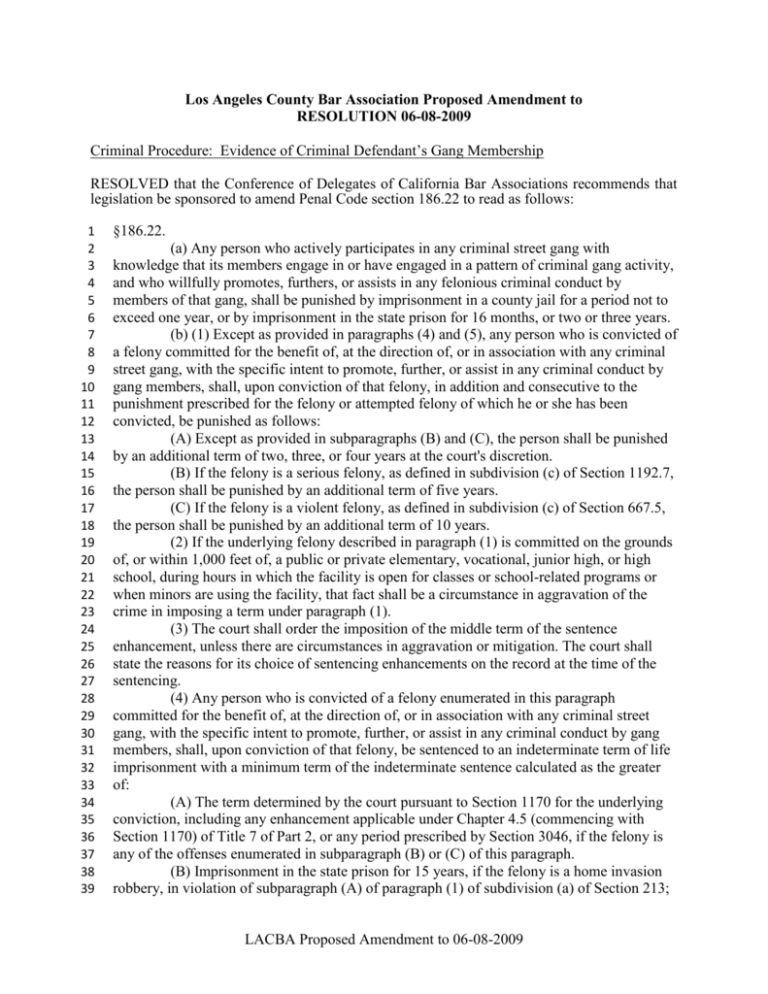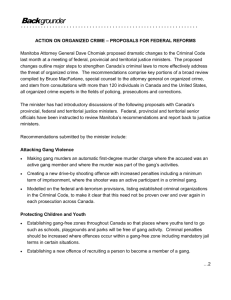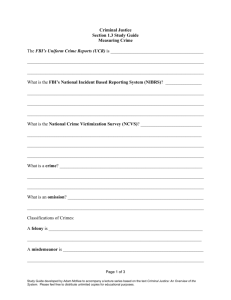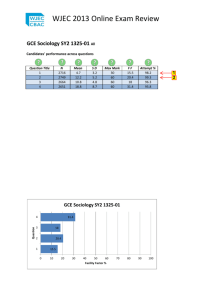06-08-2009 (lacba) - Conference of California Bar Associations
advertisement

Los Angeles County Bar Association Proposed Amendment to RESOLUTION 06-08-2009 Criminal Procedure: Evidence of Criminal Defendant’s Gang Membership RESOLVED that the Conference of Delegates of California Bar Associations recommends that legislation be sponsored to amend Penal Code section 186.22 to read as follows: 1 2 3 4 5 6 7 8 9 10 11 12 13 14 15 16 17 18 19 20 21 22 23 24 25 26 27 28 29 30 31 32 33 34 35 36 37 38 39 §186.22. (a) Any person who actively participates in any criminal street gang with knowledge that its members engage in or have engaged in a pattern of criminal gang activity, and who willfully promotes, furthers, or assists in any felonious criminal conduct by members of that gang, shall be punished by imprisonment in a county jail for a period not to exceed one year, or by imprisonment in the state prison for 16 months, or two or three years. (b) (1) Except as provided in paragraphs (4) and (5), any person who is convicted of a felony committed for the benefit of, at the direction of, or in association with any criminal street gang, with the specific intent to promote, further, or assist in any criminal conduct by gang members, shall, upon conviction of that felony, in addition and consecutive to the punishment prescribed for the felony or attempted felony of which he or she has been convicted, be punished as follows: (A) Except as provided in subparagraphs (B) and (C), the person shall be punished by an additional term of two, three, or four years at the court's discretion. (B) If the felony is a serious felony, as defined in subdivision (c) of Section 1192.7, the person shall be punished by an additional term of five years. (C) If the felony is a violent felony, as defined in subdivision (c) of Section 667.5, the person shall be punished by an additional term of 10 years. (2) If the underlying felony described in paragraph (1) is committed on the grounds of, or within 1,000 feet of, a public or private elementary, vocational, junior high, or high school, during hours in which the facility is open for classes or school-related programs or when minors are using the facility, that fact shall be a circumstance in aggravation of the crime in imposing a term under paragraph (1). (3) The court shall order the imposition of the middle term of the sentence enhancement, unless there are circumstances in aggravation or mitigation. The court shall state the reasons for its choice of sentencing enhancements on the record at the time of the sentencing. (4) Any person who is convicted of a felony enumerated in this paragraph committed for the benefit of, at the direction of, or in association with any criminal street gang, with the specific intent to promote, further, or assist in any criminal conduct by gang members, shall, upon conviction of that felony, be sentenced to an indeterminate term of life imprisonment with a minimum term of the indeterminate sentence calculated as the greater of: (A) The term determined by the court pursuant to Section 1170 for the underlying conviction, including any enhancement applicable under Chapter 4.5 (commencing with Section 1170) of Title 7 of Part 2, or any period prescribed by Section 3046, if the felony is any of the offenses enumerated in subparagraph (B) or (C) of this paragraph. (B) Imprisonment in the state prison for 15 years, if the felony is a home invasion robbery, in violation of subparagraph (A) of paragraph (1) of subdivision (a) of Section 213; LACBA Proposed Amendment to 06-08-2009 40 41 42 43 44 45 46 47 48 49 50 51 52 53 54 55 56 57 58 59 60 61 62 63 64 65 66 67 68 69 70 71 72 73 74 75 76 77 78 79 80 81 82 83 84 85 carjacking, as defined in Section 215; a felony violation of Section 246; or a violation of Section 12022.55. (C) Imprisonment in the state prison for seven years, if the felony is extortion, as defined in Section 519; or threats to victims and witnesses, as defined in Section 136.1. (5) Except as provided in paragraph (4), any person who violates this subdivision in the commission of a felony punishable by imprisonment in the state prison for life shall not be paroled until a minimum of 15 calendar years have been served. (c) If the court grants probation or suspends the execution of sentence imposed upon the defendant for a violation of subdivision (a), or in cases involving a true finding of the enhancement enumerated in subdivision (b), the court shall require that the defendant serve a minimum of 180 days in a county jail as a condition thereof. (d) Any person who is convicted of a public offense punishable as a felony or a misdemeanor, which is committed for the benefit of, at the direction of or in association with, any criminal street gang with the specific intent to promote, further, or assist in any criminal conduct by gang members, shall be punished by imprisonment in the county jail not to exceed one year, or by imprisonment in the state prison for one, two, or three years, provided that any person sentenced to imprisonment in the county jail shall be imprisoned for a period not to exceed one year, but not less than 180 days, and shall not be eligible for release upon completion of sentence, parole, or any other basis, until he or she has served 180 days. If the court grants probation or suspends the execution of sentence imposed upon the defendant, it shall require as a condition thereof that the defendant serve 180 days in a county jail. (e) As used in this chapter, "pattern of criminal gang activity" means the commission of, attempted commission of, conspiracy to commit, or solicitation of, sustained juvenile petition for, or conviction of two or more of the following offenses, provided at least one of these offenses occurred after the effective date of this chapter and the last of those offenses occurred within three years after a prior offense, and the offenses were committed on separate occasions, or by two or more persons: (1) Assault with a deadly weapon or by means of force likely to produce great bodily injury, as defined in Section 245. (2) Robbery, as defined in Chapter 4 (commencing with Section 211) of Title 8 of Part 1. (3) Unlawful homicide or manslaughter, as defined in Chapter 1 (commencing with Section 187) of Title 8 of Part 1. (4) The sale, possession for sale, transportation, manufacture, offer for sale, or offer to manufacture controlled substances as defined in Sections 11054, 11055, 11056, 11057, and 11058 of the Health and Safety Code. (5) Shooting at an inhabited dwelling or occupied motor vehicle, as defined in Section 246. (6) Discharging or permitting the discharge of a firearm from a motor vehicle, as defined in subdivisions (a) and (b) of Section 12034. (7) Arson, as defined in Chapter 1 (commencing with Section 450) of Title 13. (8) The intimidation of witnesses and victims, as defined in Section 136.1. (9) Grand theft, as defined in subdivision (a) or (c) of Section 487. (10) Grand theft of any firearm, vehicle, trailer, or vessel. (11) Burglary, as defined in Section 459. (12) Rape, as defined in Section 261. LACBA Proposed Amendment to 06-08-2009 86 87 88 89 90 91 92 93 94 95 96 97 98 99 100 101 102 103 104 105 106 107 108 109 110 111 112 113 114 115 116 117 118 119 120 121 122 123 124 125 126 127 128 129 130 131 (13) Looting, as defined in Section 463. (14) Money laundering, as defined in Section 186.10. (15) Kidnapping, as defined in Section 207. (16) Mayhem, as defined in Section 203. (17) Aggravated mayhem, as defined in Section 205. (18) Torture, as defined in Section 206. (19) Felony extortion, as defined in Sections 518 and 520. (20) Felony vandalism, as defined in paragraph (1) of subdivision (b) of Section 594. (21) Carjacking, as defined in Section 215. (22) The sale, delivery, or transfer of a firearm, as defined in Section 12072. (23) Possession of a pistol, revolver, or other firearm capable of being concealed upon the person in violation of paragraph (1) of subdivision (a) of Section 12101. (24) Threats to commit crimes resulting in death or great bodily injury, as defined in Section 422. (25) Theft and unlawful taking or driving of a vehicle, as defined in Section 10851 of the Vehicle Code. (26) Felony theft of an access card or account information, as defined in Section 484e. (27) Counterfeiting, designing, using, attempting to use an access card, as defined in Section 484f. (28) Felony fraudulent use of an access card or account information, as defined in Section 484g. (29) Unlawful use of personal identifying information to obtain credit, goods, services, or medical information, as defined in Section 530.5. (30) Wrongfully obtaining Department of Motor Vehicles documentation, as defined in Section 529.7. (31) Prohibited possession of a firearm in violation of Section 12021. (32) Carrying a concealed firearm in violation of Section 12025. (33) Carrying a loaded firearm in violation of Section 12031. (f) As used in this chapter, "criminal street gang" means any ongoing organization, association, or group of three or more persons, whether formal or informal, having as one of its primary activities the commission of one or more of the criminal acts enumerated in paragraphs (1) to (25), inclusive, or (31) to (33), inclusive, of subdivision (e), having a common name or common identifying sign or symbol, and whose members individually or collectively engage in or have engaged in a pattern of criminal gang activity. (g) Notwithstanding any other law, the court may strike the additional punishment for the enhancements provided in this section or refuse to impose the minimum jail sentence for misdemeanors in an unusual case where the interests of justice would best be served, if the court specifies on the record and enters into the minutes the circumstances indicating that the interests of justice would best be served by that disposition. (h) Notwithstanding any other provision of law, for each person committed to the Division of Juvenile Facilities for a conviction pursuant to subdivision (a) or (b) of this section, the offense shall be deemed one for which the state shall pay the rate of 100 percent of the per capita institutional cost of the Division of Juvenile Facilities, pursuant to Section 912.5 of the Welfare and Institutions Code. LACBA Proposed Amendment to 06-08-2009 132 133 134 135 136 137 138 139 140 141 142 143 144 145 146 147 148 (i) In order to secure a conviction or sustain a juvenile petition, pursuant to subdivision (a) it is not necessary for the prosecution to prove that the person devotes all, or a substantial part, of his or her time or efforts to the criminal street gang, nor is it necessary to prove that the person is a member of the criminal street gang. Active participation in the criminal street gang is all that is required. (j) A pattern of gang activity may be shown by the commission of one or more of the offenses enumerated in paragraphs (26) to (30), inclusive, of subdivision (e), and the commission of one or more of the offenses enumerated in paragraphs (1) to (25), inclusive, or (31) to (33), inclusive of subdivision (e). A pattern of gang activity cannot be established solely by proof of commission of offenses enumerated in paragraphs (26) to (30), inclusive, of subdivision (e), alone. (k) In a criminal action in which the defendant is accused of any criminal offense in which gang membership is not an element of the charged offense, evidence offered by the prosecution which does not directly prove the elements of the underlying charge[s] and is only necessary to prove special allegations pursuant to 186.22 must be presented at a bifurcated trial after the underlying charges have been tried and proved by a verdict from the trier of fact. (Proposed new language underlined; language to be deleted stricken.) PROPONENTS: Robin Bernstein-Lev, Al Menaster, Mark Harvis, James W. Gilliam, Shirley Deutsch, Danette Meyers, Phyllis Kupferstein, Herbert Barish, Michelle Michaels, Jeanmarie Warren. LACBA proposed amendment indicated by double-stricken language at line 145. LACBA Proposed Amendment to 06-08-2009







